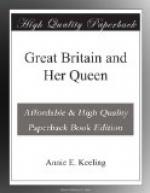[Illustration: Prince of Wales. From a Photograph by W. & D. Downey, Ebury Street, W.]
“No possible favour can the Queen grant me, or honour bestow,” said the manly writer of these words, “beyond what the poor can give the poor—her friendship.” It is rarely that one sitting amid “the fierce light that beats upon the throne” has been able to enjoy the simple bliss of true, disinterested friendship with those of kindred soul but inferior station. Such rare fortune, however, has been the Queen’s; and it is worthy of note that her special regard has been won by persons distinguished not less by loftiness and purity of character than by mental power or personal charm. She has not escaped the frequent penalty of strong affection, that of being bereaved of its objects. She has outlived earlier and later friends alike—Lady Augusta Stanley and her husband, the beloved Dean of Westminster; the good and beautiful Duchess of Sutherland; the two eminent Scotchmen, Principal Tulloch and Dr. Macleod himself; and the Archbishop of Canterbury, Dr. Tait, with his charming wife. To these might be added, among the more eminent objects of her regard, the late poet laureate, who shared with Macaulay the once unique privilege of having been raised to the peerage more for transcendent ability than for any other motive—a distinction that never would have been so bestowed by our early Hanoverian kings, and which offers a marked contrast to the sort of patronage with which later sovereigns have distinguished the great writers of their time. A new spirit rules now; of this no better evidence could be given than this recently published testimony to the relations between Queen and poet: “Mrs. Tennyson told us that the poet laureate likes and admires the Queen personally very much, and enjoys conversation with her. Mrs. Tennyson generally goes too, and says the Queen’s manner towards him is childlike and charming, and they both give their opinions freely, even when those differ from the Queen’s, which she takes with perfect good humour, and is very animated herself [Footnote].”
[Footnote: “Anne Gilchrist: her Life and Writings.” London: 1887.]
[Illustration: Princess of Wales. From a Photograph by Walery.]




